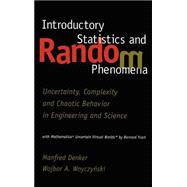| Preface | xi | (4) | |||
| Introduction | xv | (8) | |||
| Notation and Abbreviations | xxiii | ||||
| I DESCRIPTIVE STATISTICS-COMPRESSING DATA | 1 | (200) | |||
|
3 | (52) | |||
|
3 | (6) | |||
|
9 | (1) | |||
|
10 | (2) | |||
|
12 | (5) | |||
|
17 | (4) | |||
|
21 | (5) | |||
|
26 | (3) | |||
|
29 | (3) | |||
|
32 | (7) | |||
|
39 | (2) | |||
|
41 | (4) | |||
|
45 | (1) | |||
|
46 | (3) | |||
|
49 | (3) | |||
|
52 | (3) | |||
|
55 | (64) | |||
|
55 | (8) | |||
|
63 | (7) | |||
|
70 | (7) | |||
|
77 | (5) | |||
|
82 | (6) | |||
|
88 | (4) | |||
|
92 | (7) | |||
|
99 | (6) | |||
|
105 | (6) | |||
|
111 | (4) | |||
|
115 | (4) | |||
|
119 | (82) | |||
|
119 | (9) | |||
|
128 | (8) | |||
|
136 | (3) | |||
|
139 | (6) | |||
|
145 | (7) | |||
|
152 | (11) | |||
|
163 | (8) | |||
|
171 | (14) | |||
|
185 | (3) | |||
|
188 | (8) | |||
|
196 | (2) | |||
|
198 | (3) | |||
| II MODELING UNCERTAINTY | 201 | (164) | |||
|
203 | (40) | |||
|
203 | (4) | |||
|
207 | (5) | |||
|
212 | (6) | |||
|
218 | (8) | |||
|
226 | (2) | |||
|
228 | (9) | |||
|
237 | (3) | |||
|
240 | (3) | |||
|
243 | (50) | |||
|
243 | (15) | |||
|
258 | (3) | |||
|
261 | (4) | |||
|
265 | (11) | |||
|
265 | (2) | |||
|
267 | (1) | |||
|
268 | (1) | |||
|
269 | (3) | |||
|
272 | (3) | |||
|
275 | (1) | |||
|
276 | (5) | |||
|
281 | (3) | |||
|
284 | (3) | |||
|
287 | (5) | |||
|
292 | (1) | |||
|
293 | (72) | |||
|
293 | (14) | |||
|
307 | (18) | |||
|
325 | (15) | |||
|
340 | (9) | |||
|
349 | (11) | |||
|
360 | (2) | |||
|
362 | (3) | |||
| III MODEL SPECIFICATION-DESIGN OF EXPERIMENTS | 365 | (138) | |||
|
367 | (26) | |||
|
367 | (2) | |||
|
369 | (3) | |||
|
372 | (12) | |||
|
373 | (3) | |||
|
376 | (5) | |||
|
381 | (2) | |||
|
383 | (1) | |||
|
384 | (3) | |||
|
387 | (2) | |||
|
389 | (1) | |||
|
390 | (3) | |||
|
393 | (50) | |||
|
393 | (13) | |||
|
406 | (8) | |||
|
414 | (8) | |||
|
422 | (5) | |||
|
427 | (8) | |||
|
435 | (3) | |||
|
438 | (2) | |||
|
440 | (3) | |||
|
443 | (18) | |||
|
443 | (5) | |||
|
448 | (8) | |||
|
456 | (3) | |||
|
459 | (2) | |||
|
461 | (4) | |||
|
465 | (4) | |||
|
469 | (4) | |||
|
473 | (4) | |||
|
477 | (20) | |||
|
497 | (6) | |||
| Index | 503 |









